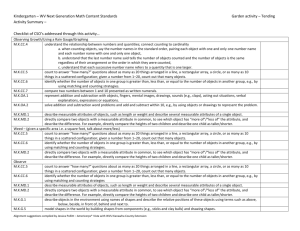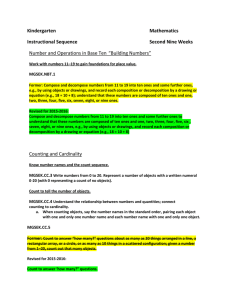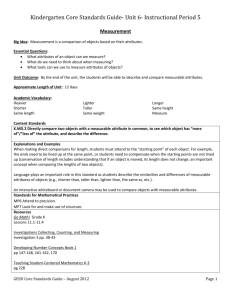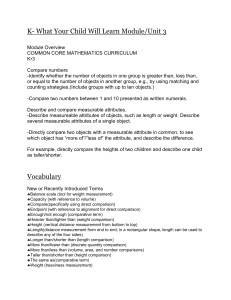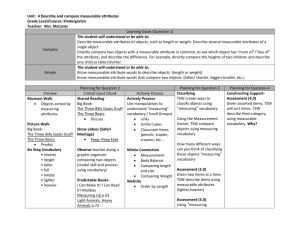Unpacked Math MD
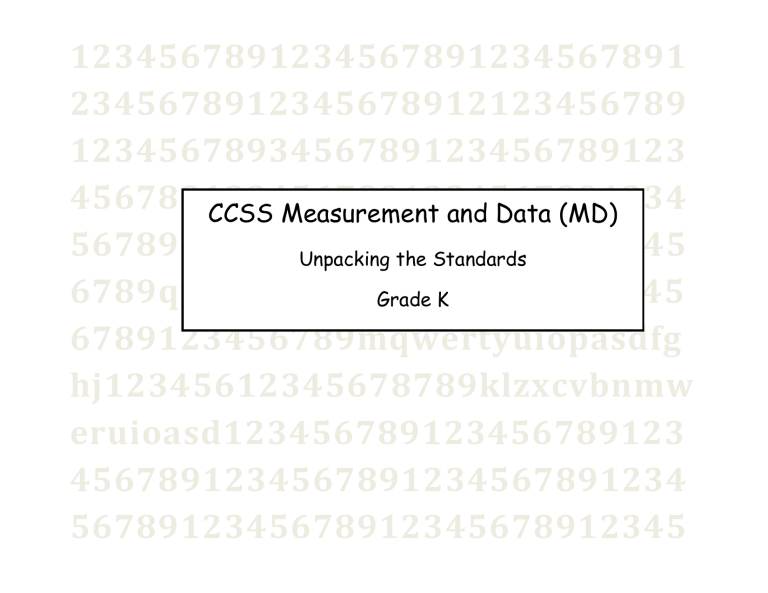
1234567891234567891234567891
2345678912345678912123456789
1234567893456789123456789123
6789123456789mqwertyuiopasdfg hj12345612345678789klzxcvbnmw eruioasd123456789123456789123
4567891234567891234567891234
5678912345678912345678912345
Standard
:
K.MD.1 Cluster (a/s)
Math Practices: MP4, MP5, MP6, MP7 Related CA Standard
MG 1.1
Describe measurable attributes of objects, such as length or weight. Describe several measurable attributes of a single object.
Essential Skills/Concepts
Distinguish measurable (e.g., length, area, volume) from non-measurable attributes (e.g., big or bigger)
(Ex: Students should say, “That pencil is
longer “rather than “That pencil is
bigger”.)
Academic Vocabulary:
Measurable attribute vocabulary such as long, heavy, wide, thin,
Teaching Notes/Strategies
Formal whole class discussions and informal exploration of attributes through the use of real objects or picture representations of objects (i.e., pencils, desks, people, toys, manipulatives, etc.)
Student conversations about the objects.
During whole class discussions, use the measurable language and encourage students to go beyond “big” or “small” or describing the color or design of an object.
Draw pictures of objects and label with measurable language to describe the object (i.e., a empty milk carton is light, taller than my finger, and empty)
Resources
Real objects available in the classroom
Chart paper
Anchor chart of measurable attributes with examples empty, full, etc.
Standard: K.MD.2 Cluster (a/s)
Math Practices: MP2, MP4, MP6, MP7 Related CA Standard
MG 1.1
Directly compare two objects with a measurable attribute in common, to see which object has “more of”/”less of” the attribute, and describe the difference. For example, directly compare the heights of two children and
describe one child as taller/shorter.
Essential Skills/Concepts
Prerequisite: use measurable attribute vocabulary when describing objects
(K.MD.1)
Compare two objects that have a measurable attribute in common.
Use correct language such as “more of”/”less of” the attribute to describe the difference. (i.e., compare the heights of two children and describe one child as being taller/shorter). More examples of correct language are below in the academic vocabulary box.
Note: When comparing two objects for length/height, be sure the ends are lined up at the same point so that students develop an understanding of conservation of length (if an object is moved, its length does not change).
Academic Vocabulary:
Measurable attribute vocabulary such as longer than, heavier than, wider than, thinner than, emptier
Teaching Notes/Strategies
Using the objects used for K.MD.1, compare objects that are similar and different modeling correct language and having students repeat.
Draw representations of objects being compared and label them with correct language (i.e. two pencils with the words “This pencil is longer.”)
Play a comparison game using cards with pictures representing objects that have a common attribute that can be compared. Looking at two comparison cards, students hold up the object that is heavier/lighter or taller/shorter when the teacher cues them.
Students should have conversations about objects they are comparing.
Station Exploration
Ask questions and have students justify their answers:
--Which box will hold more?
--Which box will hold the least?
--Will they hold the same amount?
--How could you find out?
Then you could test their answers using beans or some other material that the box would hold.
Resources
Real objects available in the classroom
Chart paper
Anchor chart of measurable attributes being compared
Cards for the comparison game (see description to the left ) than, fuller than, the same as, etc.
Standard
:
K.MD.3 Cluster (m/s/a)
Math Practices : MP1, MP2, MP3, MP6, MP7 Related CA Standard
AF 1.1
Classify objects into given categories; count the numbers of objects in each category and sort the categories by count.
Essential Skills/Concepts Teaching Notes/Strategies Resources
Prerequisite: Counting and ordering skills and understandings (K.CC.4-7)
Prerequisite: Know basic colors/shapes/sizes to do sorting.
Identify similarities and differences between objects (e.g., size, color, shape) and use these attributes to sort a collection of objects.
Be able to count the numbers of objects in each category.
Sort the categories by count.
Academic Vocabulary:
Group
Sort
Most
Least
Same different
Separate PDIM on each task: sorting, counting, and grouping before putting it all together as one task.
Class discussions/examples
Student-to-students conversations about sorting, counting, and grouping
Sample problem: From a collection of buttons, students separate the buttons into different piles based on color.
--Next, they count the number of buttons in each pile (e.g., blue—5, green—4, orange—3, purple—4).
--Finally, they organize the groups by the quantity in each group (from the smallest to the largest and groups with the same number are grouped together.
--Students should be able to tell how they sorted the object; how they labeled each set with a category; answer a variety of counting questions such as “How many..”; and compare the sorted groups using words such as “most”, “least”, “same”, and “different”.
Sorting Stations
Manipulatives:
Pattern blocks
Counting objects
Document camera to show sorting and counting to whole class
Anchor chart of different steps of this standard (sorting, counting, grouping)
